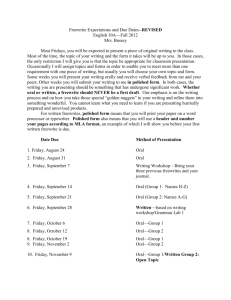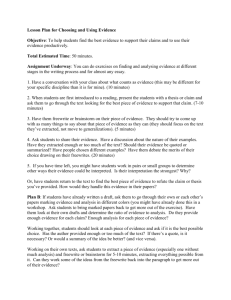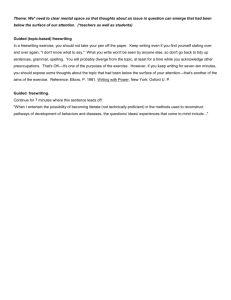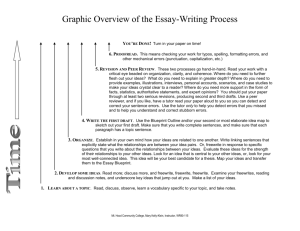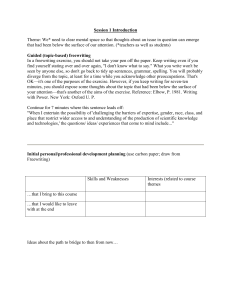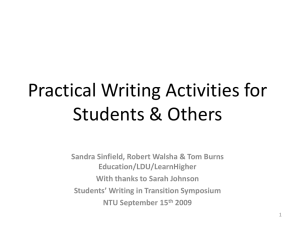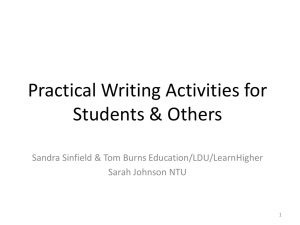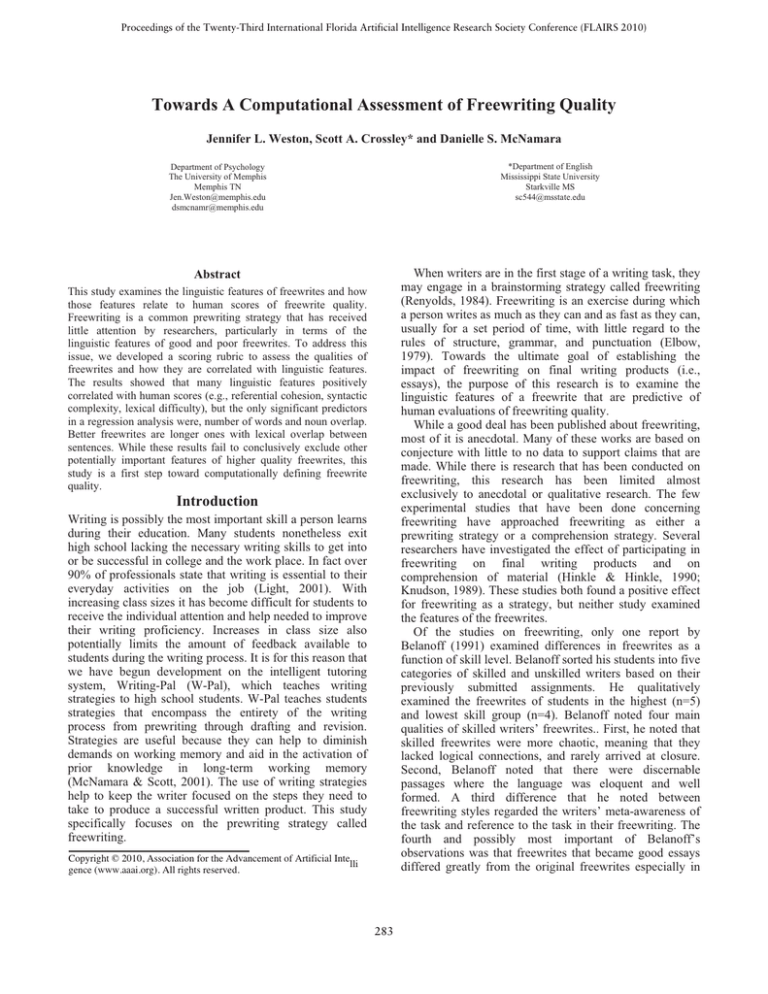
Proceedings of the Twenty-Third International Florida Artificial Intelligence Research Society Conference (FLAIRS 2010)
Towards A Computational Assessment of Freewriting Quality
Jennifer L. Weston, Scott A. Crossley* and Danielle S. McNamara
Department of Psychology
The University of Memphis
Memphis TN
Jen.Weston@memphis.edu
dsmcnamr@memphis.edu
*Department of English
Mississippi State University
Starkville MS
sc544@msstate.edu
Abstract
When writers are in the first stage of a writing task, they
may engage in a brainstorming strategy called freewriting
(Renyolds, 1984). Freewriting is an exercise during which
a person writes as much as they can and as fast as they can,
usually for a set period of time, with little regard to the
rules of structure, grammar, and punctuation (Elbow,
1979). Towards the ultimate goal of establishing the
impact of freewriting on final writing products (i.e.,
essays), the purpose of this research is to examine the
linguistic features of a freewrite that are predictive of
human evaluations of freewriting quality.
While a good deal has been published about freewriting,
most of it is anecdotal. Many of these works are based on
conjecture with little to no data to support claims that are
made. While there is research that has been conducted on
freewriting, this research has been limited almost
exclusively to anecdotal or qualitative research. The few
experimental studies that have been done concerning
freewriting have approached freewriting as either a
prewriting strategy or a comprehension strategy. Several
researchers have investigated the effect of participating in
freewriting on final writing products and on
comprehension of material (Hinkle & Hinkle, 1990;
Knudson, 1989). These studies both found a positive effect
for freewriting as a strategy, but neither study examined
the features of the freewrites.
Of the studies on freewriting, only one report by
Belanoff (1991) examined differences in freewrites as a
function of skill level. Belanoff sorted his students into five
categories of skilled and unskilled writers based on their
previously submitted assignments. He qualitatively
examined the freewrites of students in the highest (n=5)
and lowest skill group (n=4). Belanoff noted four main
qualities of skilled writers’ freewrites.. First, he noted that
skilled freewrites were more chaotic, meaning that they
lacked logical connections, and rarely arrived at closure.
Second, Belanoff noted that there were discernable
passages where the language was eloquent and well
formed. A third difference that he noted between
freewriting styles regarded the writers’ meta-awareness of
the task and reference to the task in their freewriting. The
fourth and possibly most important of Belanoff’s
observations was that freewrites that became good essays
differed greatly from the original freewrites especially in
This study examines the linguistic features of freewrites and how
those features relate to human scores of freewrite quality.
Freewriting is a common prewriting strategy that has received
little attention by researchers, particularly in terms of the
linguistic features of good and poor freewrites. To address this
issue, we developed a scoring rubric to assess the qualities of
freewrites and how they are correlated with linguistic features.
The results showed that many linguistic features positively
correlated with human scores (e.g., referential cohesion, syntactic
complexity, lexical difficulty), but the only significant predictors
in a regression analysis were, number of words and noun overlap.
Better freewrites are longer ones with lexical overlap between
sentences. While these results fail to conclusively exclude other
potentially important features of higher quality freewrites, this
study is a first step toward computationally defining freewrite
quality.
Introduction
Writing is possibly the most important skill a person learns
during their education. Many students nonetheless exit
high school lacking the necessary writing skills to get into
or be successful in college and the work place. In fact over
90% of professionals state that writing is essential to their
everyday activities on the job (Light, 2001). With
increasing class sizes it has become difficult for students to
receive the individual attention and help needed to improve
their writing proficiency. Increases in class size also
potentially limits the amount of feedback available to
students during the writing process. It is for this reason that
we have begun development on the intelligent tutoring
system, Writing-Pal (W-Pal), which teaches writing
strategies to high school students. W-Pal teaches students
strategies that encompass the entirety of the writing
process from prewriting through drafting and revision.
Strategies are useful because they can help to diminish
demands on working memory and aid in the activation of
prior knowledge in long-term working memory
(McNamara & Scott, 2001). The use of writing strategies
help to keep the writer focused on the steps they need to
take to produce a successful written product. This study
specifically focuses on the prewriting strategy called
freewriting.
Copyright © 2010, Association for the Advancement of Artificial Inte
lli
gence (www.aaai.org). All rights reserved.
283
structure. These findings suggest that the normal hallmarks
of good writing may not be adequate indicators of a
successful freewrite.
Belanoff further noted that unskilled writers’ freewrites
were structured and included full punctuation and
connectives. In addition, these freewrites were classified as
being constrained in form, consistently arriving at closure,
and showing little awareness of the task at hand. Belanoff
also noted that the freewrites of less skilled writers often
resembled their finished works of writing. Another
important difference to note between the skilled and
unskilled writers is that while skilled writers tended to ask
questions in their writing, the less skilled writers wrote
only about what they knew.
While Belanoff’s report is the only one that examined
the differences in freewrites across writers of different
ability, others have looked at freewriting products. These
reports have noted some of the same characteristics of
freewrites that were noted by Belanoff (Haswell, 1991;
Fontaine, 1991), such as their chaotic nature and the
presence of occasional eloquent passages, lending credence
to Belonoff’s assumptions about freewriting. However,
these reports were both qualitative and anecdotal in nature
and thus lack the control needed to draw broader
inferences about freewriting.
students for the 2008-2009 school year, with just under
1600 of these students attending WSHS. In spite of its size
WSHS maintains an average class size of 23 students and a
graduation rate of 99% (Carmody, 2009).
The students who wrote the freewrites were enrolled in
either an 11th grade advanced English class or a 9th grade
English class and ranged in age from 14 to 18. All of these
classes were taught by one teacher who volunteered her
classes to participate in this study. The 11th grade students
represent the highest level of student in that grade, while
the 9th graders were considered more “typical” students.
Both levels of students received the same instructions and
materials. This range of students ensures a heterogeneous
sample of essays, but we do not examine quality as a
function of grade in this study.
The data used in the present study is from a larger data
set that originally intended students to write two freewrites
with paired essays on the same prompts. In addition, they
wrote two other freewrites along with completed a set of
questionnaires. However, no class moved through the
material as quickly as expected and the second freewrite
and essay pair were never completed by the students.
Students were instructed to skip the pages corresponding to
the second freewrite-essay set and to move directly to the
first stand alone freewrite. Each student received an
experimental packet containing all of the tasks. The order
of tasks were as follows: Reading the freewriting
instructions (adapted from Elbow, 1973), a five minute
freewrite, a 25 minute essay, a five minute freewrite, and a
last five minute freewrite (only for the 11th grade students).
Each freewrite was completed on a different prompt.
Students were read the freewriting and essay instructions
and informed when to move onto the next task in their
packets. Students completed differing numbers of
freewrites depending on the time it required to distribute
experimental materials and explain the tasks. The 11th
grade classes were more cooperative and were thus able to
finish three freewrites, whereas the 9th grade classes
completed only two freewrites.
Students wrote on one of two essays prompts. These
prompts were counter-balanced and each prompt had a
matched freewriting prompt as a prewriting task. In
addition, students wrote on between one and two other
prompts for freewriting. The prompts were assigned in
groups of two from four possible prompts. These prompts
were adapted from past SAT prompts obtained from
www.onlinemathlearning.com/sat-test-prep.html.
We
presented students with slightly revised SAT writing
section instructions (The College Board, 2009).
Instructions were removed regarding the use of paper
because we provided the students with as much paper as
they needed. In addition, a reminder that the experimenter
could not clarify the prompt was added. The freewrites
were transcribed as written (i.e., spelling errors were
retained). In total, we collected 247 freewrites, of which 97
were randomly selected to be scored and used in the
current analysis. Only 97 were used because of time
constraints on the raters. The 97 freewrites represented 75
Method
Our goal is to better understand the linguistic features that
best represent human assessments of quality freewrites. If
we can predict how humans evaluate freewriting, then we
can provide more accurate feedback to W-Pal users to help
them develop and produce better quality freewrites.
Assuming a link between quality freewrites and quality
essays, we can thus better prepare writers to produce
higher quality essays, which is the goal of W-Pal. In order
to examine the linguistic features that best represent quality
freewrites, we analyzed a corpus of freewrites using
linguistic indices taken from the computational tool CohMetrix (Graesser et al., 2004). Trained raters scored the
freewrite samples using a holistic lexical proficiency
rubric. We then divided the scored writing samples into
training and test sets (Whitten & Frank, 2005). To examine
which linguistic variables were most predictive of quality
freewrites, we conducted correlations and a linear
regression model comparing the human ratings and the
Coh-Metrix indices using the training set only. The results
of this analysis were later extended using the regression
model on the independent test set data.
Corpus Collection
Freewriting samples were collected from 105 students
across 5 classes (64 9th graders and 41 11th graders) at
Webster Schroeder high school (WSHS) in Webster, New
York. WSHS is a suburban public school located in upstate
New York and is one of two high schools in the district.
The two high schools had a combined enrollment of 2961
284
different students (40 9th graders and 35 11th graders) and
were written on one of 3 different prompts (memories,
n=26; choices, n=37; and loyalty, n=34). The distribution
of freewrites across the experimental session was 24 1st
freewrites, 65 2nd freewrites, and 8 3rd freewrites.
to calculate the predictability of the variables in an
independent corpus (Witten & Frank, 2005).
We ensured that there were at least 15 times more cases
(texts) than variables (the lexical indices) to allow for a
more reliable interpretation of the multiple regression. A
15 to 1 ratio allows for the interpretation of each variable’s
individual contribution to the regression model (Field,
2005). With 64 ratings in the training set, this allowed us to
choose four linguistic variables. We used Pearson
correlations to select a variable from each bank of
measures to be used in the multiple regression. Only those
variables that demonstrated significant correlations with
the human ratings and did not exhibit multicollinearity (r
>.70) were then used in the multiple regression analysis.
The measures and their respective indices are discussed
below in reference to their importance in lexical
proficiency.
Survey Instrument
The survey instrument used in this study was a holistic
experimenter-created grading rubric. This instrument was
based on standardized grading rubrics, such as those used
by the College Board to score SAT essays. The report by
Belanoff (1991) combined with other anecdotal reports and
our own expectations were used to guide particular features
included within the rubric. The rubric focused on the
development of ideas, the use of appropriate examples,
freewrite organization, coherence, and lexical and syntactic
variety. We defined a quality freewrite within the rubric as
developing a variety of ideas with appropriate examples
using a variety of lexical and syntactic structures. It was
specified that the freewrite did not need to be well
organized, coherent, or grammatical to be of high quality.
Measures
Number of Words. The presence of more words in the
freewrite indicates that the writer was more prolific and
was able to write more on the topic. Number of words may
also be correlated with the number of ideas (Kintsch &
Keenan, 1973).
Syntactic Complexity. Syntactic complexity is measured
by Coh-Metrix in three principal ways. The first is a
measure that calculates the mean number of words before
the main verb. The second and third metrics used by CohMetrix measure the mean number of high level constituents
(sentences and embedded sentence constituents) per word
and per noun phrase. Sentences with difficult syntactic
constructions include the use of embedded constituents and
are often structurally dense, syntactically ambiguous, or
ungrammatical (Graesser et al., 2004). Consequently, they
are more difficult to process and comprehend (Perfetti et
al., 2005).
Connectives and Logical Operators. Coh-Metrix
measures the density of connectives using two dimensions.
The first dimension contrasts positive versus negative
connectives, whereas the second dimension is associated
with particular classes of cohesion identified by Halliday
and Hasan (1976) and Louwerse (2001). These connectives
are associated with positive additive (also, moreover),
negative additive (however, but), positive temporal (after,
before), negative temporal (until), and causal (because, so)
measures. The logical operators measured in Coh-Metrix
include variants of or, and, not, and if-then combinations.
Connectives and logical operators play an important role in
the creation of cohesive links between ideas and clauses
(Crismore, Markkanenen, & Steffensen, 1993; Longo,
1994).
Causality. Causal cohesion is measured in Coh-Metrix by
calculating the ratio of causal verbs to causal particles
(Graesser et al., 2004). The incidence of causal verbs and
causal particles in a text relates to the conveyance of causal
content and causal cohesion. The causal verb count is
based on the number of main causal verbs identified
Human Ratings
To assess the 97 writing samples that comprise our written
corpus, two native speakers of English who were
experienced composition instructors were trained as expert
raters. The raters were trained on an initial selection of
freewrites taken from a training corpus not included in the
written corpus used in the study. The raters assigned each
freewrite a score between 1 (minimum) and 6 (maximum).
To assess inter-rater reliability, Pearson correlations
calculated between the raters’ responses on the training set
exceeded .70 (p <.001).The average correlation between
the three raters on the target freewrites was .77 (p <.001),
showing an acceptable level of agreement.
Variable selection
The linguistic indices used in this study were provided by
Coh-Metrix (Graesser et al., 2004). Coh-Metrix is a
computational tool that reports on over 600 linguistic
indices related to conceptual knowledge, cohesion, lexical
difficulty, syntactic complexity, and simple incidence
scores. Because of the text size of many of the freewrites,
not all indices could be investigated. For instance, many of
the freewrites were only one paragraph in length, making
paragraph to paragraph comparisons impossible. Also,
many freewrites comprised fewer than 100 words, the
minimum threshold needed for lexical diversity measures.
We used a training set to identify which of the CohMetrix variables best correlated to the human scores
assigned to each freewrite. Following Whitten and Frank
(2005), we divided the corpus into two sets: a training set
(n = 64) and a testing set (n = 33) based on a 67/33 split.
These variables selected from the training set were then
used to predict the human scores in the training set, using a
linear regression model. The freewrites in the test set were
analyzed using the regression model from the training set
285
through WordNet (Fellbaum, 1998; Miller et al., 1990).
Causal verbs and particles help the reader infer the causal
relations in the text (Kintsch & van Dijk, 1978).
Lexical Overlap. Coh-Metrix considers four forms of
lexical overlap between sentences: noun overlap, argument
overlap, stem overlap, and content word overlap. Noun
overlap measures how often a common noun of the same
form is shared between two sentences. Argument overlap
measures how often two sentences share nouns with
common stems (including pronouns), while stem overlap
measures how often a noun in one sentence shares a
common stem with other word types in another sentence
(not including pronouns). Content word overlap refers to
how often content words are shared between sentences at
binary and proportional intervals (including pronouns).
Lexical overlap has been shown to aid in text
comprehension and reading speed (Douglas, 1981; Kintsch
& van Dijk, 1978; Rashotte & Torgesen, 1985).
Semantic Co-referentiality. Coh-Metrix measures
semantic co-referentiality using Latent Semantic Analysis
(LSA; Landauer, McNamara, Dennis, & Kintsch, 2007), a
mathematical technique for representing deeper world
knowledge based on large corpora of texts. LSA uses a
general form of factor analysis to condense a very large
corpus of texts to approximately 300 dimensions. These
dimensions represent how often a word occurs within a
document (defined at the sentence level, the paragraph
level, or in larger sections of texts) and each word,
sentence, or text becomes a weighted vector (Landauer &
Dumais, 1997; Landauer, Foltz, & Laham, 1998). Unlike
lexical overlap indices of co-referentiality, LSA measures
associations between words based on semantic similarity,
which can be used to assess the amount of semantic
coreferentiality in a text (Crossley, Louwerse, McCarthy,
& McNamara, 2007). Coh-Metrix also assesses
given/newness through LSA by measuring the proportion
of new information each sentence provides. The given
information is thought to be recoverable from the
preceding discourse (Halliday, 1967) and does not require
activation (Chafe, 1975).
Word Characteristics. Coh-Metrix reports on a variety of
lexical indices taken from WordNet (Fellbaum, 1998;
Miller, G., Beckwith, Fellbaum, Gross & Miller, K., 1990)
and MRC Psycholinguistic Database (Wilson, 1988). CohMetrix derives hypernymy and polysemy indices from
WordNet. Hypernymy indices relate to the specificity of
words (cat vs animal). A lower hypernymy score equates
to less specific word choices. Polysemy indices relate to
how many senses a word contains. Some words have more
senses (e.g., class) while others have fewer (e.g., apricot).
The more senses a word has, the more ambiguous it is.
From the MRC Psycholinguistic Database, Coh-Metrix
derives indices of word familiarity, word concreteness, and
word imagability. All of these indices relate to the
accessibility of core lexical items. Core items are closer to
prototypical items so higher scores equate to words that are
more concrete or more familiar and imagable. The MRC
indices are based on the works of Paivio (1965), Toglia
and Battig (1978) and Gilhooly and Logie (1980), who
used human subjects to rate large collections of words for
psychological properties.
WordFrequency. Word frequency indices measure how
often particular words occur in the English language. The
Coh-Metrix frequency indices derive their frequency
counts from CELEX (Baayen, Piepenbrock, & Gulikers,
1995), which uses frequency counts based on the majority
of the words in the text. CELEX is a database from the
Centre for Lexical Information, which consists of
frequencies taken from the early 1991 version of the
COBUILD corpus, a 17.9 million word corpus.
Results
Pearson Correlations Training Set
Pearson Correlations from the training set demonstrated
that indices from seven measures reported significant
correlations with the human ratings. The seven variables
along with their r values and p values are presented in
Table 1, sorted by the strength of the correlation. Because
we were limited to four variables to protect the model from
overfitting, we selected the four variables that
demonstrated the highest Pearson correlation when
compared to the human ratings of the freewriting samples
and that were not conceptually related.
Table 1
Selected Variables Based on Person Correlations
Number of Words
r value
0.664**
Noun Overlap
0.360*
LSA Given Information
0.349*
Number of Words before Main Verb
0.300*
Hypernymy
0.268*
Variable
Word Familiarity
0.277*
Word Meaningfullness
0.264*
*p < .05; ** p < .001
Multiple Regression Training Set
A stepwise linear regression analysis was conducted that
regressed the four variables (number of words, noun
overlap, LSA given information and mean number of
words before the main verb) onto raters’ score for the 64
freewrites in the training set The variables were checked
for outliers and multicollinearity. Coefficients were
checked for both variance inflation factors (VIF) values
and tolerance. All VIF values were at about 1 and all
tolerance levels were well beyond the .2 threshold,
indicating that the model data did not suffer from
multicollinearity (Field, 2005).
The stepwise linear regression using the four variables
yielded a significant model, F(2, 61) = 30.732, p <.000;
286
adj. r2 =.486. Significant predictors were number of words
( =.620, p < .000) and noun overlap ( =.250, p < .05).
The results from the stepwise linear regression demonstrate
that these two variables account for 49% of the variance in
the human evaluations of freewriting quality for the 64
essays examined in the training set.
The strong correlation between the predicted scores and
actual scores in the test set demonstrate that the salient
linguistic features identified in the training set are not
unique to that data set. The regression analysis conducted
on the test set using forced entry of the significant
variables from the training set explained more variance in
that set than in the training set, approximately 10% more.
In this study, we were able to identify two significant
linguistic features of quality freewrites, which explained
between 49 and 58% of the variance associated with the
human scores. Nonetheless, a larger sample of freewrites
may provide the ability to distinguish other linguistic
features that are predictive of human ratings of freewrite
quality. The sample size in this study limited the number of
predictors that could be used in the analysis. A larger
sample size would provide the opportunity to more
thoroughly analyze other features thought to be important
to freewrite quality (word characteristics, causality,
connectives and logical operators etc) and determine what,
if any, predictive effects they have on human ratings of
freewrite quality.
While we have established the presence of two linguistic
features in freewrites that are predictive of higher graded
freewrites, without the corresponding essays, we lack the
means to determine whether freewrite quality; as we have
defined it leads to better essay results. If higher quality
freewrites (as rated by humans) lead to lower quality
essays, or vice versa, then our judgment of which
characteristics should be present in a high quality freewrite
will need to be reevaluated. Our future research agenda
entails examining how these freewrites transform into
essays.
It is our hope that with further research we will be able
to assess freewriting quality in comparison with essay
quality and be able to develop a quantitative assessment for
freewriting using computational tools. Through the use of
computational tools such as Coh-Metrix, we will be able to
provide real time feedback to students who are learning to
freewrite more effectively. Through the freewriting and
other strategy modules in W-Pal, we hope to scaffold
students toward building better writing skills.
Test Set Model
To further support the results from the multiple regression
conducted on the training set, we used the B weights and
the constant from the training set multiple regression
analysis to estimate how well the model would function on
an independent data set (the 33 scored freewritings samples
in the independent test set). The prediction equation
produced an estimated value for each writing sample in the
test set. We then conducted a Pearson Correlation between
the estimated score and the actual score. We used this
correlation along with the adjusted r2 from running a linear
regression on the test data with the training model to
demonstrate the strength of the model on an independent
data set. The prediction equation was Y’= .924
+.022(number of words) + .855(noun overlap). Predicted
scores for the test set significantly correlated with the
actual scores, r = .715, p < .000.The model for the test set
yielded an adj. r2 =.581, p <.000. The results from the test
set model demonstrate that the combination of these
variables accounted for 58% of the variance in the
evaluation of the 33 freewriting samples comprising the
test set.
Discussion
Based on the prior qualitative research combined with
intuitive notions of the function of freewriting, we
developed a rubric that emphasized the number of ideas
generated, the appropriateness of examples, organization,
coherence, and syntactic and lexical variety. The
regression analysis of linguistic features on score showed
that the only significant predictors of freewriting quality
were the mean number of words and noun overlap. When
looking at these findings in conjunction with the holistic
freewriting rubric, we can begin to draw some interesting
inferences on what drives freewriting quality.
The purpose of freewriting is to produce a large number
of ideas quickly. This being said, it makes sense that
number of words is a significant predictor of human scores
of freewrite quality. Those students who wrote more likely
produced more ideas and thus likely had higher rated
freewrites because the number of ideas was a major criteria
on which the freewrites were rated. Furthermore the
significance of noun overlap is consistent with prior claims
that a better freewrite has a larger number of overlapping
ideas. These findings suggest that not only are the writers
generating ideas but that these ideas are related to each
other. The results further show that some of the features we
identified as markers of quality freewrites can be
computationally identified using Coh-Metrix.
Acknowledgements
This research was supported by the Institute for Education
Sciences (IES R305G020018-02; IES R305A080589). Any
opinions, findings, and conclusions or recommendations
expressed in this material are those of the authors and do
not necessarily reflect the views of the IES. We would also
like to thank our expert raters, Kristen Dechert and Joshua
Thompson, for their help in evaluating the quality of the
freewrites and Karen Savella for allowing us to come into
her classroom.
References
287
Baayen, R. H., Piepenbrock, R. and Gulikers, L. 1995. The
CELEX Lexical Database (Release 2) [CDROM].
Philadelphia, PA: Linguistic Data Consortium, University
of Pennsylvania.
Belanofff, P. 1991. Freewriting: an Aid to Rereading
Theorists. In P. Belanofff, P. Elbow and S. I. Fontaine eds.
Nothing begins with N. 16-32. Carbondale and
Edwardsville: Southern Illinois University Press.
Carmody, A. 2009.Vote May19, 2009-2010 Budget
Proposal.
Retrieved
from
http://www.websterschools.org/files/filesystem/200910%2
0Budget%20Newsletter.pdf
Chafe, W. L. 1975. Givenness, Contrastiveness,
Definiteness, Subjects, Topics, and Point of View. In: C.
N. Li eds.Subject and Topic 26-55. New York: Academic.
The College Board. 2005-2008. SAT Essay Prompts.
Retrieved from: http://www.onlinemathlearning.com/sattest-prep.html.
Crismore, A., Markkanen, R., Steffensen, M. S. 1993.
Metadiscourse in Persuasive Writing: A Study of Texts
Written by American and Finnish University Students.
Written Communication. 10: 39-71
Crossley, S. A., Louwerse, M. M., McCarthy, P. M. and
McNamara, D. S. 2007. A Linguistic Analysis of
Simplified and Authentic texts. Modern Language Journal.
91(2): 15-30.
Douglas, D. 1981. An Exploratory Study of Bilingual
Reading Proficiency. In S. Hudelson ed., Learning to Read
in Different Languages 33-102. Washington, DC: Center
for Applied Linguistics.
Elbow, P. 1973. Writing without Teachers. New York:
Oxford University Press.
Fellbaum, C. 1998. WordNet: An Electronic Lexical
Database. Cambridge, MA: MIT Press.
Graesser, A.C., McNamara, D.S., Louwerse, M.M., and
Cai, Z. 2004. Coh-Metrix: Analysis of text on cohesion and
language. Behavioral Research Methods, Instruments, and
Computers. 36: 193-202.
Halliday. M. A. K. 1967. Notes on Transitivity and Theme
in English. Journal of Linguistics. 3: 199-244.
Halliday, M. A. K., and Hasan, R. 1976.Cohesion in
English. London: Longman.
Haswell, R. H. 1991. Bound Forms in Freewriting: the
Issue of Organization. In P. Belanofff, P. Elbow and S. I.
Fontaine eds. Nothing begins with N. 32-71. Carbondale
and Edwardsville: Southern Illinois University Press.
Hinkle, S., and Hinkle, A. 1990. An Experimental
Comparison of the Effects of Focused Freewriting and
other
Study
Strategies
on
Lecture
Comprehension. Teaching of Psychology. 17(1): 31-35.
Kintsch, W., and van Dijk, T. A. (1978). Toward a model
of Text Comprehension and Production. Psychological
Review. 85: 363-394.
Knudson, R. E. 1989. Effect of Instructional Strategies on
Children’s Informational Writing. The Journal of
Educational Research.,83(2): 91-96.
Field, A. 2005. Discovering Statistics Using SPSS.
London: Sage Publications, Ltd.
Fontaine, S. I. 1991. Recording and Transforming: the
Mystery of the Ten-minute Freewrite. In P. Belanofff, P.
Elbow and S. I. Fontaine eds. Nothing begins with N..3-16.
Carbondale and Edwardsville: Southern Illinois University
Press.
Gilhooly, K. J. and Logie R. H. 1980. Age of Acquisition,
Imagery, Concreteness, Familiarity and Ambiguity
Measures for 1944 Words. Behaviour Research Methods
and Instrumentation. 12: 395–427.
Landauer, T. K. and Dumais, S. T. 1997. A Solution to
Plato’s Problem: The Latent Semantic Analysis Theory of
the Acquisition, Induction, and Representation of
Knowledge. Psychological Review. 104: 211–240.
Landauer, T. K., Foltz, P. W., and Laham D. 1998.
Introduction to Latent Semantic Analysis. Discourse
Processes. 25: 259–284.
Landauer, T., McNamara, D. S., Dennis, S., and Kintsch,
W. eds. 2007. Handbook of Latent Semantic Analysis.
Mahwah, NJ: Erlbaum.
Light, R. J. 2001. Making the Most of College: Students
Speaking Their Minds. Cambridge: Harvard University
Press.
Longo, B. 1994. Current Research in Technical
Communication: The Role of Metadiscourse in
Persuasion. Technical Communication. 41 : 348–352.
Louwerse, M. M. 2001. An Analytic and Cognitive
Parameterization of Coherence Relations. Cognitive
Linguistics. 12: 291–315.
McNamara, D. S., Crossley, S. A., and McCarthy, P. M.
Linguistic Features of Writing Quality. Written
Communication. Forthcoming.
McNamara, D. S., and Scott, J. L. 2001. Working Memory
Capacity and Strategy Use. Memory and Cognition. 29: 1017.
Miller, G. A, Beckwith, R., Fellbaum, C., Gross, D. and
Miller, K. 1990. Five Papers on WordNet. Cognitive
Science Laboratory. Princeton University, No. 43.
Paivio, A. (1965). Abstractness, Imagery, and
Meaningfulness in Paired-Associate Learning. Journal of
Verbal Learning and Verbal Behavior. 4: 32–38.
Perfetti,. C. A.,. Landi, N., and Oakhill, J. 2005. The
Acquisition of Reading Comprehension Skill. In M. J.
Snowlmg andand C. Hulme eds. The Science of Reading: A
Handbook . 227-247. Oxford: Blackwell.
Rashotte, C. A., and Torgesen,J. K (1985). Repeated
Reading and Reading Fluency in Learning Disabled
Children. Reading Research Quarterly. 20: 180-188.
Renyolds, M. 1984. Freewritings Origin..The English
Journal. 73(3): 81-82.
Toglia, M. P. and W. R. Battig (1978). Handbook of
Semantic Word Norms. New York: Lawrence Erlbaum
Associates.
Whitten, I. A., and Frank, E. 2005. Data Mining. San
Francisco: Elsevier.
Wilson, M.D. 1988. The MRC Psycholinguistic Database:
Machine Readable Dictionary, Version 2. Behavioural
Research Methods, Instruments and Computers. 201: 6-11.
288

